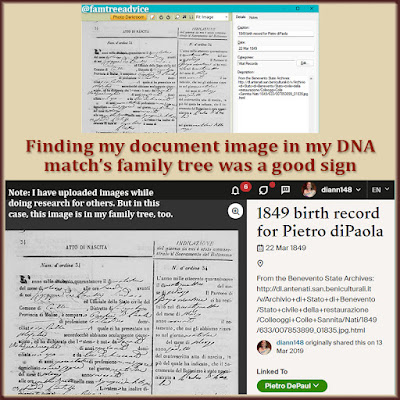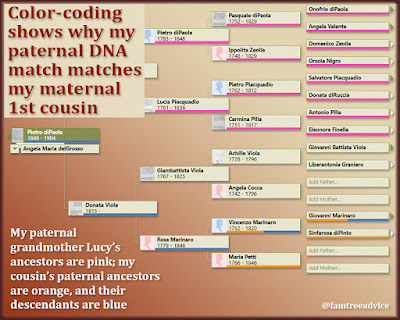Wouldn't it be great if they made everyone who took a DNA test post a family tree? We want your family at least up to your great grandparents. That's only 15 people, and the living people will be private.
We'd all have an easier time of figuring out our DNA matches if we could see their great grandparents. That's why I'm hopeful when a DNA match's family tree shows a double-digit person count.
I figured out 2 new DNA matches today by following 3 key steps. Now, it doesn't always work out. And I skip right over any match with no tree or a single-digit tree. But if they have a decent tree, these steps can lead straight to the solution.
1. Check Shared Matches to Isolate a Branch
Which DNA-testers do you and your match have in common? Seeing familiar names here can tell you which branch your match fits into. For example, if shared matches include Dad's maternal cousins, they belong on Grandma Lucy's line.
It helps a lot to know you're looking for family members from a particular branch of your family tree.
 |
| Your shared DNA matches can pull your focus to a particular branch of your family tree. |
For one of the matches I solved, there were only 4 distant matches in our shared list. But 3 of the 4 had last names from a town on Mom's maternal side of the family. Right off the bat, I knew our connection came from the town of Santa Paolina, Avellino, Italy.
2. View Their Tree for Familiar Names
My Santa Paolina match has a tree with 16 people. I noticed she's only Italian on her mother's side. I'm nothing but Italian, so that's all I need to investigate.
Her mother's maiden name was not familiar to me, but her grandmother's name did ring a bell. My match's grandmother was a deSpirito, the daughter of Felice deSpirito. I was pretty sure deSpirito is a Santa Paolina name.
Having taken steps 1 and 2, I'm very confident this DNA match has roots in Santa Paolina. My connection to the town is only through my 2nd great grandmother and her paternal family. We're off to the races!
3. Research Their Family to Find the Connection
My DNA match's tree says her grandmother was born in 1889. That told me her Italian birth record should be available online. As it happens, I've downloaded and renamed every available Santa Paolina vital record. They're searchable on my computer with a desktop search program called Everything from voidtools. I typed in my match's grandmother's name and found her birth record!
While the grandmother and her parents were not in my family tree, their ancestors were. I searched the town's records to build out this family tree branch. Now I know my DNA match's grandmother is my 3rd cousin 3 times removed. My match is my 5th cousin once removed.
The other DNA match I figured out today is a shared match with my Dad and my maternal 1st cousin Nick. Nick and Dad are DNA matches, and both have roots in one town. All the shared matches for this DNA match point to my paternal town of Colle Sannita, Benevento, Italy.
This DNA match is Italian only on her father's side. I recognized one last name immediately. It's a name that has morphed into 2 or 3 spellings in America.
Her family tree has 67 people, so brava to her. I checked out her father's line and saw a few Italian document images that she'd borrowed from my family tree. That's a good sign!
 |
| This DNA match has obviously seen my family tree and cashed in on my research. Good! |
When I went to her ancestors in my own family tree, I saw that her 3rd great grandfather is my 4th great uncle. His brother is the great grandfather of my paternal grandmother Lucy.
So where is the connection to my maternal 1st cousin Nick? As I looked at these people in my family tree, I found my answer. My DNA match's 3rd great grandfather married Nick's 1st cousin 4 times removed. I saw this because of the color-coding in my Family Tree Maker file.
 |
| Color-coding your family tree is like planting seeds you'll harvest later. |
My DNA match shares ancestors with me through my paternal grandmother Lucy. And with my maternal cousin Nick through his father's side. I know exactly where this match belongs in my family tree.
As I said, things won't always work out. But you can set yourself up for lots of DNA success stories if you:
- Check shared matches
- View their tree
- Research their family
How many DNA mysteries can you scratch off your list now?
My ancestry is Piemontese. I don't have a lot of matches in Ancestry DNA to those lines. One of the biggest problems are trees that have people mixed up. I have seen the documents in Italian and know they are different people with exactly the same name. Three guys named Antonio Fenoglio Gaddò. All about the same age having babies about the same time. One was my great great grandfather. Another was his first cousin. The third one I have not identified yet. The problem is (unlike American research) the same families have been living in these little towns in Italy for much longer. Some as far back as the Middle Ages. Their connections may not be available in records available online like Family Search. Tons of guys named Giovanni Battista and women named Maria with the same last names. So necessary to find ALL of the documents which is what I do. Latin, Italian and some in French.
ReplyDeleteI agree completely. It still amazes me when 2 or 3 couples with the same names are having kids at the same time. This is exactly why I'm reviewing every last available document from my towns to try to make the best possible choices.
DeleteI have about 1500 people in my tree. Most of my DNA matches have 20 or less people in their tree. In fact most have "no tree". It's frustrating. I appreciate the tips on reviewing DNA matches. Is there any usefulness in the "no tree" matches?
ReplyDeleteI haven't been able to do anything with matches who have no trees. You may glean some ideas from their shared matches, but you can't get anywhere unless you find them on Facebook and figure out more from context.
Delete